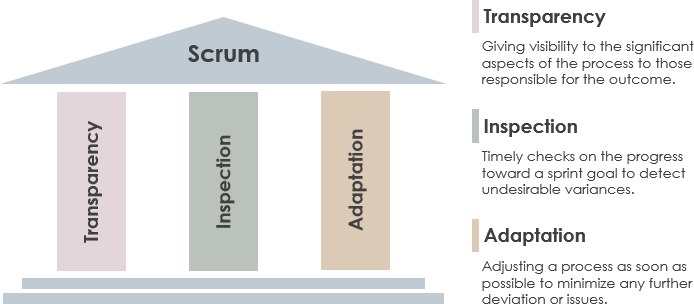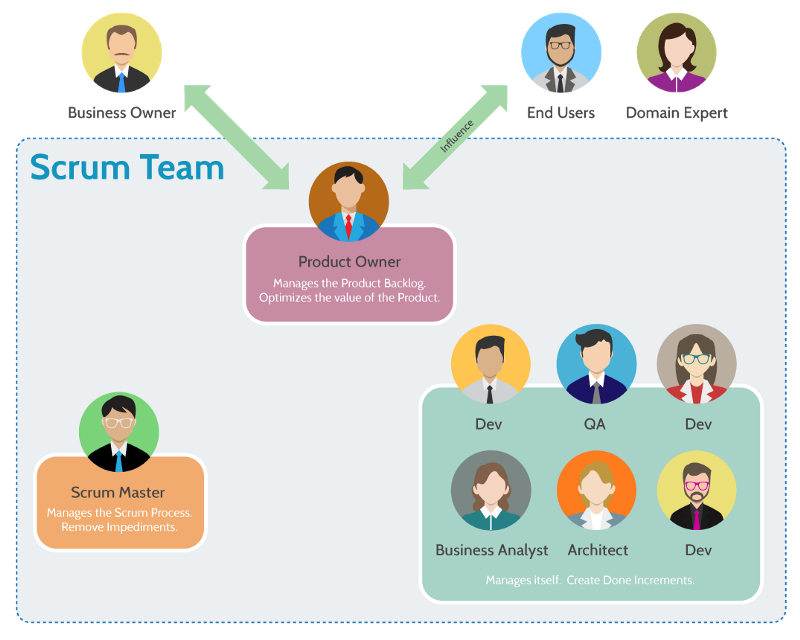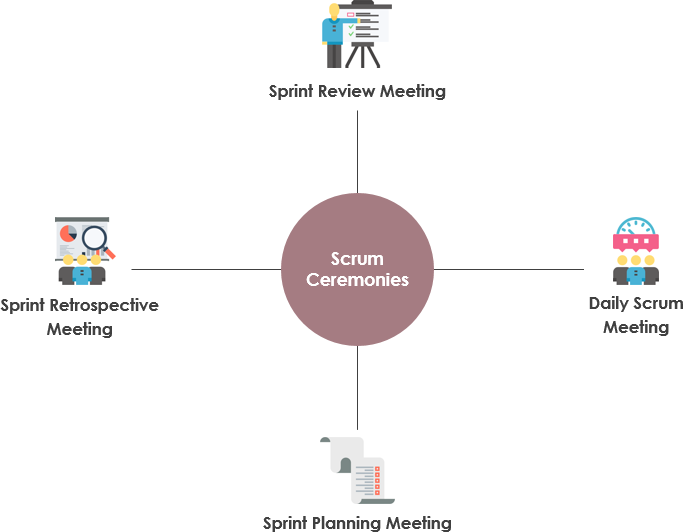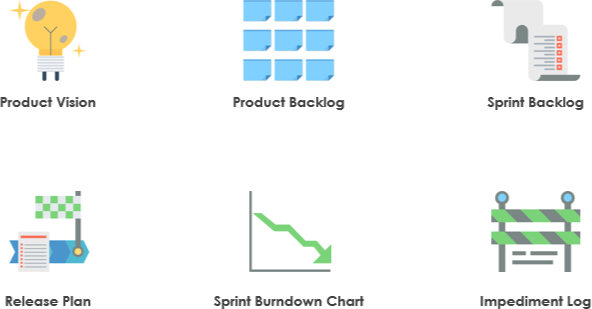اسکرامبر اساس تجربیگرایی است که بر سه جنبه مهم (که به عنوان سه رکندر شکل زیر نشان داده شده است) و از هر پیادهسازی کنترل فرآیند تجربی حمایت میکند: شفافیت، بازرسی و سازگاری.

زمانی که تیمهای اسکراماین ارزشها را تجسم و تمرین میکنند ارزشهاتعهد، شجاعت، تمرکز، باز بودن و احترام، ارکان شفافیت، بازرسی و سازگاری اسکرام ظهور میکنند و اعتماد را برای همه ایجاد میکنند. اعضای تیم اسکرام این ارزشها را هنگام برخورد با نقشها، رویدادها و آثار اسکرام یاد میگیرند و بررسی میکنند.
اطمینان از شفافیت — تیم اسکرام
اسکرام شفافیت را درون و بیرون تیم افزایش میدهد. شفافیت برای فرآیند اسکرام حیاتی است زیرا به همه اجازه میدهد ببینند و درک کنند که در هر اسپرینت چه اتفاقی در حال وقوع است، که منجر به ارتباط و اعتماد بهتر و بیشتر درون تیم میشود.

تیمها میتوانند به طرق مختلف شفاف باشند. در اینجا برخی از کارهایی که میتوانیم برای دستیابی به آن انجام دهیم را فهرست میکنم:
نزدیکتر کار کنید و بازخورد سریعتر بگیرید
تیمهای اسکرام باید در نحوه کار خود شفاف باشند: ذینفعان را به هم نزدیکتر کنند، روزانه با آنها کار کنند، اجازه دهند بازخورد در هر دو جهت جریان یابد و ریسک اتخاذ یک جهت یا دیگری را به اشتراک بگذارند.
پیشرفت کار را بیشتر قابل مشاهده کنید
تیمها میتوانند پیشرفت را قابل مشاهده کنند: نمودارهای سوختن و تختههای سفید روشهای سنتی برای نشان دادن پیشرفت اهداف اسپرینت هستند. این ابزارهای ساده میتوانند پیشرفت هر مرحله از برنامه را، از اسپرینت تا چشمانداز، نشان دهند که میتواند به طور مؤثری گفتگوی «کی میتواند تمام شود؟» را کاهش دهد.
تیم میتواند پیشرفت را قابل مشاهده کند: نمودارهای سوختن و یک تخته سفید روشهای سنتی برای نشان دادن پیشرفت در برابر اهداف اسپرینتیک گزارش ساده برای نشان دادن پیشرفت در تمام سطوح برنامهریزی، از اسپرینت تا چشمانداز، میتواند به طرز شگفتانگیزی در کاهش تعداد گفتگوهای «کی تمام خواهد شد؟» مؤثر باشد.
جریان آزاد اطلاعات بهروز
اطلاعات باید در هر دو جهت جریان یابد. ذینفعان و کسانی که در نقشهای محصول هستند، به ویژه کسانی که به طور مستقیم با یک تیم کار میکنند، باید شفاف باشند. جهتگیری محصول به شکل نقشههای راه، برنامههای انتشار یا تعریف انجام شدهمیتواند برای تیم قابل مشاهده باشد تا آنها از اهداف کلی و انتظاراتی که متعهد به ارائه آن هستند، آگاه شوند.
اسکرام مستر میتواند کمک کند
در اسکرام، این تیم نیست که برای اسکرام مستراست، بلکه اسکرام مستر است که تلاش میکند کار تیم توسعه را تسهیل کند. اسکرام مستر باید با مالک محصول، تیم توسعه و سایر طرفهای درگیر کار کند تا بفهمد آیا رویدادها و آثار به طور کامل شفاف هستند یا خیر. اسکرام مستر باید به همه کمک کند تا در غیاب شفافیت کامل، مناسبترین شیوهها را به کار ببرند. یک اسکرام مستر میتواند با بازرسی آثار، حس کردن الگوها، گوش دادن دقیق به آنچه گفته میشود و تشخیص تفاوتها بین نتایج مورد انتظار و واقعی، شفافیت ناقص را شناسایی کند.
شفافیت در رویدادها
اسپرینتیک ظرف برای تمام رویدادهای دیگر است و هر رویداد در اسکرام یک فرصت رسمی برای بازرسی و سازگاری چیزی است. این رویدادها به طور خاص برای ایجاد شفافیت و بازرسی حیاتی طراحی شدهاند. عدم گنجاندن هر یک از این رویدادها منجر به کاهش شفافیت میشود و یک فرصت از دست رفته برای بازرسی و سازگاری است.
شفافیت یکی از جنبههای مهم در فرآیند اسکرام است که باید برای کسانی که مسئول نتیجه هستند، قابل مشاهده باشد. شفافیت نیاز دارد که این جنبهها در فعالیتها و آثار روزمره تعریف شوند تا تیم بتواند درک مشترکی از آنچه که مشاهده میشود، به اشتراک بگذارد.

به عنوان مثال:
جلسه برنامهریزی اسپرینت
جلسه برنامهریزی اسپرینتجلسه برنامهریزی اسپرینتدر ابتدای اسپرینت برگزار میشود تا لیست کارهای اسپرینتموارد را درک و مستند کند. این جلسه برگزار میشود تا اطمینان حاصل شود که همه افراد درگیر به وضوح میدانند که چه کاری باید انجام دهند تا به توسعه آن تکرار افزایشی خاص کمک کنند.
جلسه ایستاده روزانه اسکرام
جلسه روزانه اسکراماسکرام روزانهبر روی بازتاب روزانه مشارکتهای تیم در اسپرینت خاص متمرکز است. این جلسه به سه سوال پاسخ میدهد:
- در ۲۴ ساعت گذشته چه چیزی را برای دستیابی به هدف روزانه اسپرینت توسعه دادهام؟
- امروز چه کاری انجام خواهم داد تا به هدف بعدی اسپرینت خود برسم؟
- موانع کار دیروز که مانع از دستیابی به هدف من هستند، چیست؟
اسکرام روزانه از نظر به اشتراکگذاری همه این موارد بدون ترس از اعتراف به اشتباهات فردی بسیار حیاتی است. اگر به اشتراک گذاشته نشود، پروژه پیچیده میشود و باعث تأخیر و در نهایت خطر شکست پروژه میشود.
جلسه بازبینی اسپرینت
جلسه بازبینی اسپرینت در پایان اسپرینت برگزار میشود تا آنچه که برای تکمیل آن به عنوان افزودهای به محصول انجام شده است، بررسی شود. تیم از ذینفعان دعوت میکند تا بازخورد خود را در مورد اسپرینت ارائه دهند، که این بازخوردها به فهرست تولید محصول توسط مالک محصول، برای بهبود اسپرینتهای بعدی گنجانده میشود.
جلسه بازنگری اسپرینت
بازنگری اسپرینت برای بررسی اسپرینت گذشته از نظر افراد، تعاملات، فرآیند و ابزارها برگزار میشود و برای پذیرش اقدامات بهبود از این اسپرینت برای توسعه اسپرینت بعدی انجام میشود. این کار به شفافیت در گزارشدهی و ارتباطات نیاز دارد.
شفافیت در آثار
اسکرام تعداد زیادی آثار که به عنوان رادیاتورهای اطلاعات برای تمام مراحل اسکرام عمل میکنند. اطلاعات به وضوح برای تیم قابل مشاهده و قابل درک میشود تا روند پیشرفت پروژه شناخته شود. در دسترس بودن و وضوح اطلاعات برای اتخاذ تصمیمات هوشمندانه بسیار مهم است.

فهرست تولید محصول
فهرست تولید محصول فهرستی مرتبشده از نیازمندیها است که بر اساس اولویت و اهمیت توسط مالک محصول و تیم اولویتبندی میشود. تمامی ویژگیها، خصوصیات، اصلاحات و بهبودهای شناختهشده در فهرست تولید محصول مستند میشوند تا برای تیم واضح و قابلفهم باشد.
فهرست بازنگری اسپرینت
فهرست بازنگری اسپرینت پس از جلسه برنامهریزی اسپرینت انجام شده و فهرست تولید محصول نهایی شده است. این فهرست شامل داستانهای کاربری است که برای توسعه یک افزوده کامل از محصول لازم است. معمولاً برخی از موارد فهرست تولید محصول به وظایف یا داستانهای کاربری که تیم بر روی آنها توافق کرده است، تجزیه میشود.
نمودارهای کاهش — وضعیت توسعه
استفاده کنیدنمودارهای کاهش تا در مورد نحوه عملکرد تیم در یک اسپرینت خاص صادق باشید. یک نمودار کاهش داستان واقعی از نحوه عملکرد تیم را نشان میدهد. نمودارهای کاهش میزان تلاش باقیمانده در آینده برای تکمیل اسپرینت را نشان میدهند.
تابلوی وظایف اسکرام
تابلوهای اسکرام همچنین برای نمایش سه چیز در هنگام کار بر روی یک اسپرینت استفاده میشود:
- چه باید کرد؟
- چه در حال انجام است؟
- چه انجام شده است؟
تعریف انجامشده
شفافیت همچنین به شدت با تعریف انجامشده مرتبط است. تعریف رسمی معنای ‘انجامشده’ باعث کاهش تغییرات و احتمال انجام نشدن کارها میشود و اندازهگیری پیشرفت بهطور قطعی (‘انجامشده’ یا ‘انجامنشده’) شفافیت را افزایش میدهد.
داشتن یک تعریف انجامشده به این معناست که کارهای انجامنشده در سیستم شما وجود دارد. این کارهای انجامنشده همچنین باعث کمبود شفافیت میشود. ریسکها در آن پنهان میشوند. برای مثال، اگر تستهای عملکردی انجام نشوند، ریسک یک سیستم غیرعملکردی تا نزدیکی انتشار به تعویق میافتد — زمانی که بیشترین آسیب را وارد میکند.
نتیجهگیری
اسکرام بر اساس شفافیت است که از طریق رویدادها و آثار آن نمایان میشود، اما نمیتوان آن را به دست آورد اگر شفافیت و ارتباطات در تیم وجود نداشته باشد. ایجاد و حفظ شفافیت کامل دشوار است اگر اعضا تردید داشته باشند یا از اشتراکگذاری اشتباهات خود بترسند. در واقع، هر کس در تیم باید درک و احترام متقابل را نشان دهد. مالک محصول و اسکرام مستر باید تیمها را به اشتراکگذاری هرگونه ریسک یا مشکلی که در کار خود با آن مواجه میشوند، ترغیب و تشویق کنند. در حالی که تیمها نباید تنها بر دستاوردهای فردی خود تمرکز کنند، بلکه باید برای دستیابی به اهداف مشترک پروژه تلاش کنند. تمامی این بازخوردها و اشتراکگذاریها برای ایجاد و حفظ شفافیت کامل جریان اطلاعات مهم هستند که امکان بهبود مستمر سازمان و تیم را فراهم میآورد.
This post is also available in Deutsch, English, Español, Français, Bahasa Indonesia, 日本語, Polski, Portuguese, Ру́сский, Việt Nam, 简体中文 and 繁體中文.













